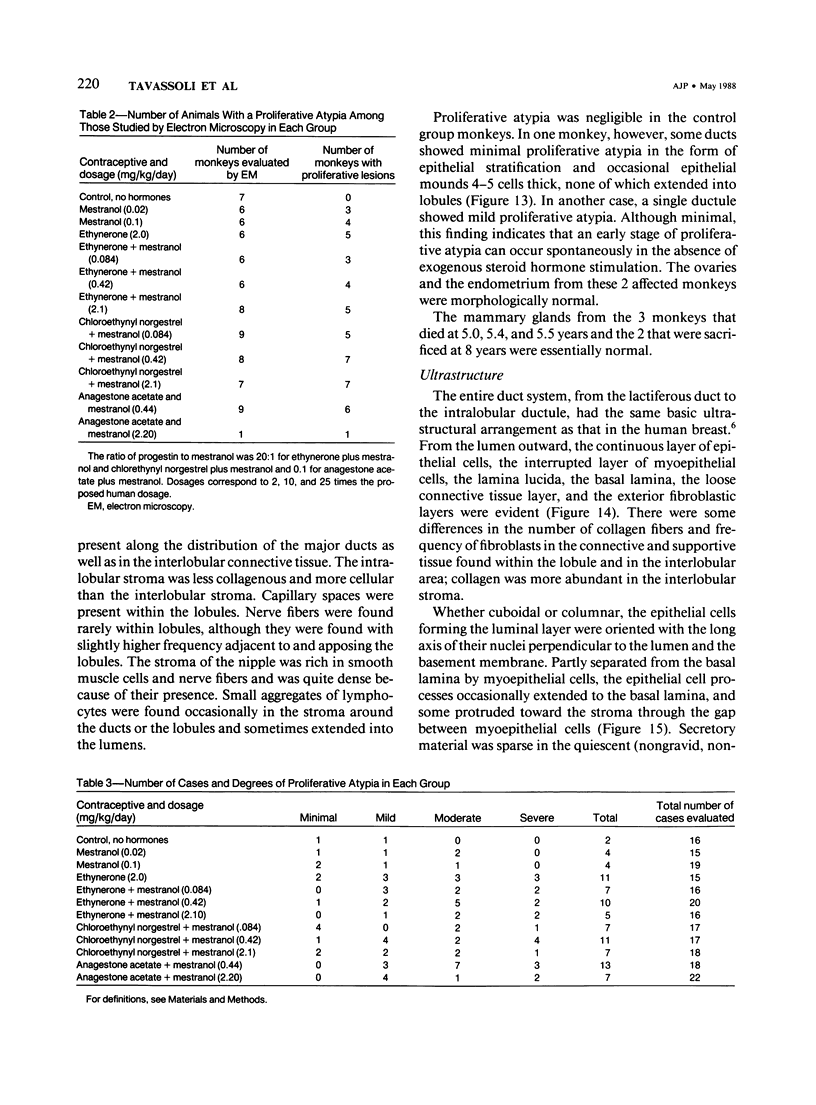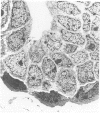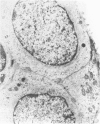Abstract
A total of 213 treated and 16 control monkeys comprising 12 experimental groups was evaluated for determination of the long-term (10 years) effects of various dosages of a variety of synthetic oral contraceptive steroids on the mammary glands of rhesus monkeys. The steroid hormones included mestranol, ethynerone, a combination of mestranol and ethynerone, chlorethynyl norgestrel plus mestranol, and anagestone acetate plus mestranol. Various degrees of physiologic lobular hyperplasia and lactational changes were observed in association with all of these steroid hormones; these changes appeared dose-dependent. Mestranol caused a proliferative atypia ranging from a minimal to a moderate degree in 8 of 34 (23%) animals, but it was not dose-related. Eleven of 15 monkeys (73%) administered ethynerone developed proliferative atypia, ranging in degree from minimal to severe, including one invasive carcinoma and 2 lesions resembling intraductal carcinoma in the human. The mestranol and ethynerone combination produced a proliferative atypia in 22 of 52 animals (42%), including five identical to intraductal carcinoma in the human and one identical to lobular neoplasia. Of the 40 monkeys administered anagestone acetate and mestranol, 20 (50%) developed proliferative atypias; the atypias ranged from mild to severe and included five resembling intraductal carcinoma in human breast. The chloroethynyl norgestrel and mestranol combination induced proliferative atypia in 25 of 52 monkeys (49%); six of these atypias were severe and indistinguishable from intraductal carcinoma of the human breast; and one, if in the human breast, would reflect a solid variant of an invasive carcinoma. Only 2 of the 16 control monkeys (12%) developed proliferative atypias, and these were of minimal to mild degree. The occurrence of severe degrees of atypia identical to intraductal carcinoma in the human breast and invasive carcinoma associated with hormone administration suggests a carcinogenic effect.
Full text
PDF





















Images in this article
Selected References
These references are in PubMed. This may not be the complete list of references from this article.
- Brack M. Carcinoma solidum simplex mammae bei einem Orang-Utan (Pongo pygmaeus) Zentralbl Allg Pathol. 1966;109(5):474–480. [PubMed] [Google Scholar]
- Casey H. W., Giles R. C., Kwapien R. P. Mammary neoplasia in animals: pathologic aspects and the effects of contraceptive steroids. Recent Results Cancer Res. 1979;66:129–160. doi: 10.1007/978-3-642-81267-5_4. [DOI] [PubMed] [Google Scholar]
- Casey H. W., Giles R. C., Kwapien R. P. Mammary neoplasia in animals: pathologic aspects and the effects of contraceptive steroids. Recent Results Cancer Res. 1979;66:129–160. doi: 10.1007/978-3-642-81267-5_4. [DOI] [PubMed] [Google Scholar]
- Chopra H. C., Mason M. M. A new virus in a spontaneous mammary tumor of a rhesus monkey. Cancer Res. 1970 Aug;30(8):2081–2086. [PubMed] [Google Scholar]
- Drill V. A., Martin D. P., Hart E. R., McConnell R. G. Effect of oral contraceptives on the mammary glands of Rhesus monkeys: a preliminary report. J Natl Cancer Inst. 1974 May;52(5):1655–1657. doi: 10.1093/jnci/52.5.1655. [DOI] [PubMed] [Google Scholar]
- Fechner R. E. The surgical pathology of the reproductive system and breast during oral contraceptive therapy. Pathol Annu. 1971;6:299–319. [PubMed] [Google Scholar]
- GESCHICKTER C. F., HARTMAN C. G. Mammary response to prolonged estrogenic stimulation in the monkey. Cancer. 1959 Jul-Aug;12(4):767–781. doi: 10.1002/1097-0142(195907/08)12:4<767::aid-cncr2820120422>3.0.co;2-2. [DOI] [PubMed] [Google Scholar]
- Geil R. G., Lamar J. K. FDA studies of estrogen, progestogens, and estrogen/progestogen combinations in the dog and monkey. J Toxicol Environ Health. 1977 Sep;3(1-2):179–193. doi: 10.1080/15287397709529557. [DOI] [PubMed] [Google Scholar]
- Kirschstein R. L., Rabson A. S., Rusten G. W. Infiltrating duct carcinoma of the mammary gland of a rhesus monkey after administration of an oral contraceptive: a preliminary report. J Natl Cancer Inst. 1972 Feb;48(2):551–556. [PubMed] [Google Scholar]
- LiVolsi V. A., Stadel B. V., Kelsey J. L., Holford T. R., White C. Fibrocystic breast disease in oral-contraceptive users. A histopathological evaluation of epithelial atypia. N Engl J Med. 1978 Aug 24;299(8):381–385. doi: 10.1056/NEJM197808242990803. [DOI] [PubMed] [Google Scholar]
- Macpherson E. E., Montagna W. Proceedings: The mammary glands of rhesus monkeys. J Invest Dermatol. 1974 Jul;63(1):17–18. doi: 10.1111/1523-1747.ep12677294. [DOI] [PubMed] [Google Scholar]
- O'Conor G. T. Using primates in medical reseach. 2. Recent comparative research. Cancer--a general review. Primates Med. 1969;3(0):9–22. [PubMed] [Google Scholar]
- Olsson H., Olsson M. L., Möller T. R., Ranstam J., Holm P. Oral contraceptive use and breast cancer in young women in Sweden. Lancet. 1985 Mar 30;1(8431):748–749. doi: 10.1016/s0140-6736(85)91280-2. [DOI] [PubMed] [Google Scholar]
- Oral-contraceptive use and the risk of breast cancer. The Cancer and Steroid Hormone Study of the Centers for Disease Control and the National Institute of Child Health and Human Development. N Engl J Med. 1986 Aug 14;315(7):405–411. doi: 10.1056/NEJM198608143150701. [DOI] [PubMed] [Google Scholar]
- Page D. L., Dupont W. D., Rogers L. W., Rados M. S. Atypical hyperplastic lesions of the female breast. A long-term follow-up study. Cancer. 1985 Jun 1;55(11):2698–2708. doi: 10.1002/1097-0142(19850601)55:11<2698::aid-cncr2820551127>3.0.co;2-a. [DOI] [PubMed] [Google Scholar]
- Pastides H., Kelsey J. L., LiVolsi V. A., Holford T. R., Fischer D. B., Goldenberg I. S. Oral contraceptive use and fibrocystic breast disease with special reference to its histopathology. J Natl Cancer Inst. 1983 Jul;71(1):5–9. [PubMed] [Google Scholar]
- Trapido E. J., Brinton L. A., Schairer C., Hoover R. Estrogen replacement therapy and benign breast disease. J Natl Cancer Inst. 1984 Nov;73(5):1101–1105. [PubMed] [Google Scholar]






























